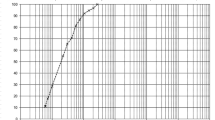Abstract
Difficulties in construction operations are often associated with clay soils. However, the engineering behaviour of such soils can be improved by stabilizing them with the addition of small amounts of cementitious materials. Nonetheless because clay soils possess a range of mineralogical compositions some are more easy to estabilize than others. In order to investigate this problem, three of the principal components found in clays, namely, kaolinite, montmorillonite and quartz, were chosen. These three components were treated with varying amounts of cement plus PFA. and lime plus PFA. PFA was used as an extender with cement and with lime to evaluate how effective such mixtures are when used to stabilize clay soils. The addition of PFA reduces the cost of the stabilizing agent.
Because stabilization of clay soils most frequently has been used in connection with road construction, kaolinite, montmorillonite and quartz were subjected to the types of test used in the design procedure for roadways, that is, consistency limit tests, compaction tests, California bearing ratio tests, unconfined compressive tests, and tests to determine Young's modulus. Except for those samples used for assessment of consistency limits, the others were prepared with optimum values of moisture content and maximum dry density. Those samples used for unconfined compression and modulus of elasticity measurements were cured for different periods of time. The results of the various tests were examined to see if there was an optimum amount for a particular addition which would bring about maximum enhancement of engineering performance of the components concerned.
Generally mixtures of cement and PFA or lime and PFA did not give as good results as when cement and lime were used on their own. Also those mixtures with the highest proportions of cement and of lime usually gave the better improvement in values. Nevertheless it may be worth making some sacrifice in soil improvement to obtain the saving in cost that the use of PFA brings.
Résumé
Les problèmes rencontrés lors des travaux de génie civil sont souvent liés aux sols argileux. Cependant le comportement de ces sols peut être amélioré en les stabilisant à l'aide de petites quantités de matériaux apportant un effet de cimentation. Malgré tout certains sols sont plus faciles à stabiliser que d'autres car leur composition en minéraux argileux peut être très variée. Afin d'étudier le problème, trois des principaux composants trouvés dans les argiles, c'est-à-dire la kaolinite, la montmorillonite et le quartz ont été choisis. Ces trois composants ont été traités avec des teneurs variées en ciment cendres volantes pulvérisées et en chaux additionnée des mêmes cendres volantes. Les cendres ont été utilisées comme un apport au ciment et à la chaux afin d'évaluer l'efficacité de ces mélanges quand on les utilise pour stabiliser des sols argileux. L'ajout de cendres réduit le coût de l'agent stabilisateur.
Comme la stabilisation des sols argileux a été surtout utilisée en construction routière, la kaolinite, la montmorillonite et le quartz ont été soumis aux essais routiers classiques, c'est-à-dire limités d'Atterberg, essais de compactage, C.B.R., résistance en compression et enfin module de Young. En dehors des échantillons utilisés pour les limites d'Atterberg, tous ont été préparés à la teneur en eau optimale et à la densité sèche maximale. Les échantillons utilisés pour les essais de résistance en compression et les mesures du module d'élasticité ont subi des durées de cure variables. Les résultats obtenus ont été examinés pour voir s'il existait une teneur optimale pour un ajout particulier et qui apporterait une amélioration maximale du comportement des composants traités. En général les mélanges ciment-cendres et chaux-cendres n'ont pas donné des résultats aussi satisfaisants que les traitements à la chaux ou au ciment seuls. On a aussi constaté qu'on obtenait les meilleurs résultats avec les teneurs les plus élevées en ciment et en chaux.
Cependant il faut mettre en balance d'un côté une moindre amélioration des sols et de l'autre les économies réalisées en utilisant des cendres volantes.
Similar content being viewed by others
References
ANON, 1979: Classification of rocks and soils for engineering geological mapping. Part I—Rock and soil materials. Bulletin International Association Engineering Geology, No. 19, pp. 364–371.
BELL F.G., 1976: The influence of the mineral content of clays on their stabilization with cement. Bulletin Association Engineering Geologists, Vol. 13, pp. 267–278.
BELL F.G. and TYRER M.J., 1987: Lime stabilization and clay mineralogy. Proceedings International Conference on Tunnels and Foundations'87, London, (Ed. Forde M.C.), Engineering Technics Press, Edinburgh, pp. 1–7.
BELL F.G. and COULTHARD J.M., 1990: Stabilization of clay soils with lime. Municipal Engineer, Vol. 7, pp. 125–140.
Author information
Authors and Affiliations
Rights and permissions
About this article
Cite this article
Bell, F.G. An assessment of cement-PFA and lime-PFA used to stabilize clay-size materials. Bulletin of the International Association of Engineering Geology 49, 25–32 (1994). https://doi.org/10.1007/BF02594997
Published:
Issue Date:
DOI: https://doi.org/10.1007/BF02594997




